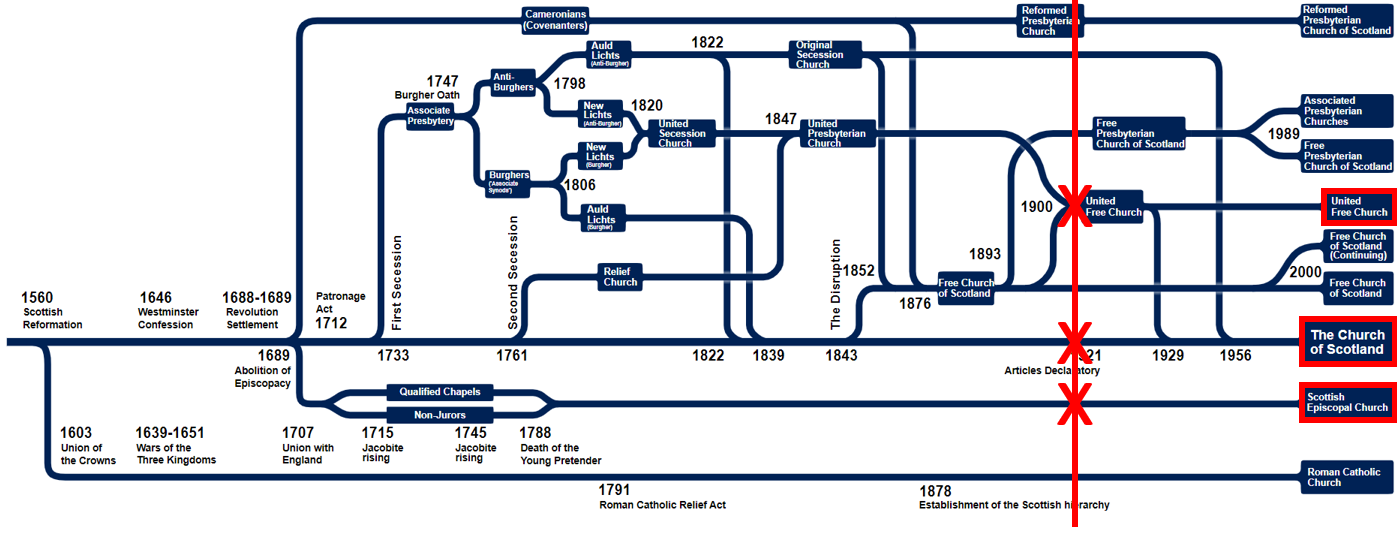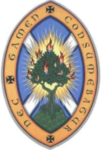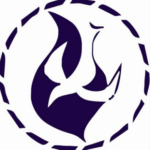There were six well-attended churches in Langholm, belonging to four denominations, giving a good insight into Scottish ecclesiastical issues and local church influence.
| Denomination | Congregation Known As | Minister in 1915 |
|---|---|---|
| Church of Scotland | Langholm Parish Church | James Buchanan |
| United Free Church of Scotland | North UF | George Orr |
| United Free Church of Scotland | South UF | James MacDonald |
| United Free Church of Scotland | Chalmers | David Inglis |
| Scottish Episcopal Church | All Saints | Alderson Seaton |
| Congregational Union of Scotland | EU Congregational Church | Robert Smith |
The Church of Scotland, United Free Church of Scotland and Scottish Episcopal Church are shown in the timeline diagram below, each marked with a red X in 1915. The Congregational Union of Scotland was a relatively minor denomination and is not shown.

There was also a property in the 1915 valuation roll with the Plymouth Brethren listed as the tenant, although no indication of their activities is indicated in the E&L in that year. Langholm native David Beattie appears to have belonged to the Plymouth Brethren, but lived in Carlisle.
The Church of Scotland is the country’s national church by law but, unlike the Church of England, is independent of the state. It was founded in 1560 during the Scottish Reformation, led chiefly by John Knox, breaking away from the Roman Catholic Church. The UK monarch is the Supreme Governor of the Church of England but attends the Church of Scotland as an ordinary member and has been obliged since the Treaty of Union in 1707 to preserve it as ‘the settlement of the true Protestant religion as established by the laws made in Scotland’. The church is presbyterian, meaning that it is governed by elders and has no bishops. Its senior body is known as the General Assembly, chaired by a moderator who holds the position for a year.

The United Free Church was formed in 1900 from the merger of the United Presbyterian Church of Scotland and part of the Free Church of Scotland, both of which had their origins in splits from the Church of Scotland. The ‘UP’ Church traced its roots back to the First and Second Secessions (1733 and 1761) and the Free Church to ‘the Disruption’ (1843), all three secessions involving protest about local congregations not being able to appoint their own ministers due to a patronage system controlled by landowners.

The Scottish Episcopal Church was formed in 1689 when the Church of Scotland abolished bishops, a decision rejected by Scottish episcopalians (the Latin episcopus means bishop, from the Greek episkopos, ‘overseer’). Many of its congregations adopted Anglican forms of worship, and it is now a member of the worldwide Anglican Communion, although retaining some independence from the Church of England. It was sometimes referred to as the ‘Laird’s Kirk’, as a large proportion of the Scottish aristocracy were episcopalians, such as the 6th and 7th Dukes of Buccleuch.

The Congregational Union of Scotland was formed in 1812 as part of a Protestant movement that adhered to the principle of each congregation being autonomous, with no overseeing body except to provide coordination and assistance. In 1896, it was joined by the Evangelical Union, created in 1843 after Rev James Morison was expelled from the United Secession Church for taking a position that the church viewed as being incompatible with the theology developed by John Calvin, a Protestant reformer. The combination of their heritages resulted in emphases on mission and temperance.